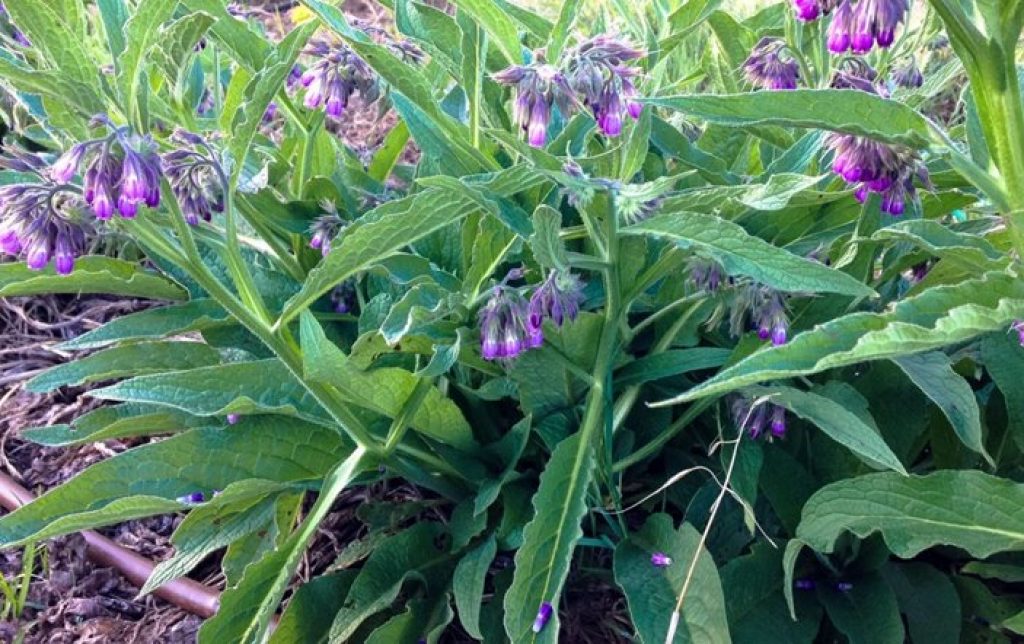The comfrey’s attractive foliage and showy spring flowers that are mostly creamy yellow with some types having red, purple, blue, or red-purple flowers make these ornamental plants a perfect choice by many people. Will rabbits eat my comfrey or not?
Comfrey is a common name for the about 35 species of plants in the genus Symphytum in the family Boraginaceae (the borage family), which has borage, fiddleneck, oysterplant, heliotrope, forget-me-not, Salvation Jane, among others. Common ones include Common and Russian comfrey as well as Symphytum tuberosum, Symphytum asperum, and Symphytum caucasicum.

Rabbits can eat comfrey plants in moderation as a treat, just as you do to other herbs such as cilantro, sage, lavender, tarragon, peppermint, dill, oregano, basil, and so on. You can offer them dry or fresh comfrey leaves. Depending on their size, 1-2 leaves are enough.
However, it is not one of their most favored plants, and some may not like it. Additionally, there are concerns about comfrey’s safety to rabbits, which we want to look at next.
Is comfrey safe for rabbits?
The Rabbit Welfare Association & Fund, a UK-based organization that helps improve UK’s pet rabbits’ care, lists it as poisonous. Is it toxic or not? Let us look at a few studies before we can talk more about comfrey and rabbits.
One study on “Toxicity and metabolism of pyrrolizidine alkaloids” notes that while pyrrolizidine alkaloids (PA) caused toxicity signs and irreversible hepatic damage, this will not be the case with rabbits. The study notes that “small herbivores such as sheep, goats, rabbits, guinea pigs, and other herbivorous laboratory animals are highly resistant to PA toxicity, associated with a low rate of hepatic production of reactive metabolites (pyrroles) and(or) a high rate of activity of detoxifying enzymes.
A second study also reveals that Senecio species that are high in pyrrolizidine alkaloids didn’t cause “gross lesions or changes in serum protein and albumin occurred, in rabbits.” Only microscopic changes in liver tissues were noted.
A third study concludes that “nonruminant herbivores (rabbits, gerbils, guinea pigs, hamsters) were resistant to tansy ragwort which has pyrrolizidine alkaloid while horses and cattle are vulnerable.
Finally, In vitro biotransformation of pyrrolizidine alkaloids in different species. Part I: Microsomal degradation notes that goats, sheep, and rabbits are almost resistant.
The above studies vindicate the safety of comfrey to rabbits. However, this is not the same as humans. While comfrey has been consumed as a vegetable for centuries, and its roots are used in traditional medicine to treat bruises, burns, muscle sprains, and joint inflammation, it is not safe for humans if ingested.
The Food and Drug Administration and many European nations have banned oral consumption of comfrey or its products since it has pyrrolizidine alkaloids that can cause severe liver damage, cancers, or death.
Benefits
Comfrey has vitamin A, promoting good sight and healthy skin, bones, soft tissue, and teeth. Vitamin A also boosts immunity, helps in maintaining cell membrane integrity, among other roles. Therefore, it is suitable for nursing, or pregnant does, as well as ill and weak rabbits, making it one of the best tonic herbs to give your furry friend.
It will also help in digestion and prevent the formation of hairballs, making it useful during molting when the chances of wool blocks are high.
Thirdly, according to Rise and Shine Rabbitry, comfrey helps with “snuffles to premature kindling and helping milking does produce more milk. I have no scientific proof, other than never seeing any of their rabbits sick.”
Finally, if your rabbits are stressed, consider giving them one or two comfrey leaves for calming effects.
Avoid too much
While it is beneficial, don’t give your rabbit too much comfrey as it can cause soft stool and diarrhea, just as any other greens. Remember, only hay is provided in your rabbit diet in an unlimited amount, while pellets and greens are limited.
If you need to use it during winter, dry some just as you do with hay. Bunnies will still enjoy eating this herb just as they do with the fresh one.
